#vaella targaryen (daughter of daeron and kiera)
Photo
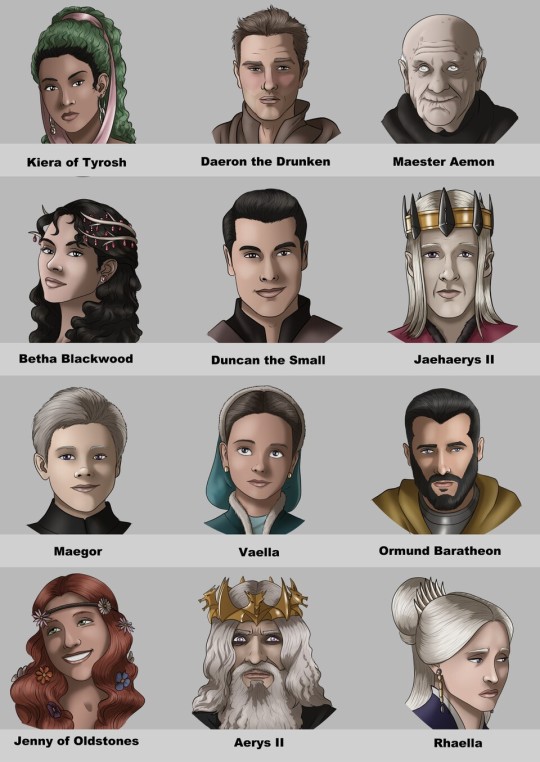

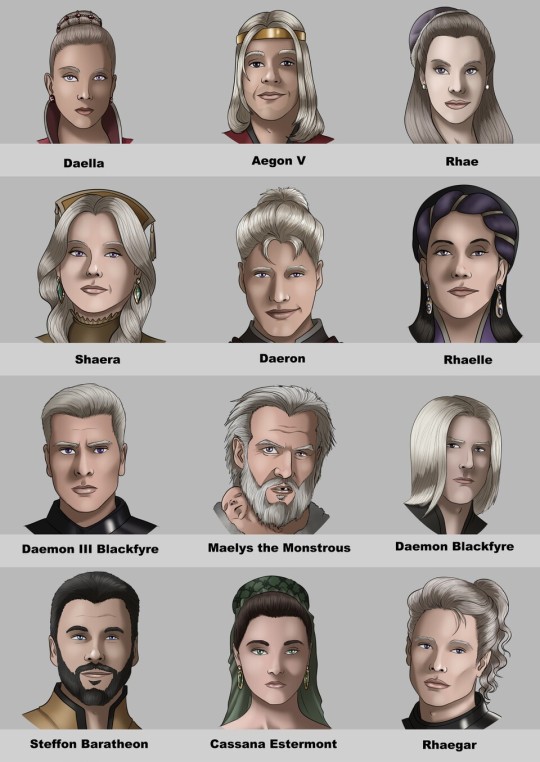

The Royal Families of The Seven Kingdoms: Part 5
By Jota Saraiva
#a song of ice and fire#kiera of tyrosh#daeron (son of maekar) targaryen#daella (daughter of maekar) targaryen#aegon v targaryen#rhae targaryen#betha blackwood#duncan targaryen#jaehaerys ii targaryen#shaera targaryen#daeron (son of aegon v) targaryen#rhaelle targaryen#maegor (son of aerion) targaryen#vaella (daughter of daeron) targaryen#daemon iii blackfyre#maelys blackfyre#daemon blackfyre#jenny of oldstones#aerys ii targaryen#rhaella targaryen#steffon baratheon#cassana estermont#rhaegar targaryen#fanart#artstation
146 notes
·
View notes
Photo

Ladies of House Targaryen:
Vaella, daughter of Daeron and Kiera
#vaella targaryen#vaella targaryen daughter of daeron#vaella targaryen daughter of kiera#house targaryen#loht#valyrianscrolls#asoiaf#quoth queue quoth i
50 notes
·
View notes
Text
Vaella Targaryen


Daughter of Daeron Targaryen and Kiera of Tyrosh. She was taken into consideration for the throne when King Maekar died but she was passed over due to the fact that she was considered ‘simple-minded’. My headcannons are that she was very close with her mother and would wear the same makeup her mother wore. I also believe that she was very artistic and would often paint, she wore brighter colors and would often coordinate with her mother. After she was passed over for the throne she was free to explore her passions, i also hc that she married somebody from the reach since they are known for their shared love of bright colors.
I added two versions with different eye colors.
#asoiaf#game of thrones#a song of ice and fire#asoif/got#asoif fanart#asoiaf fanart#house of the dragon#house targaryen#King maekar#maekar targaryen#vaella targaryen#kiera of tyrosh
42 notes
·
View notes
Text

𝐕𝐚𝐞𝐥𝐥𝐚 𝐨𝐟 𝐒𝐮𝐦𝐦𝐞𝐫𝐡𝐚𝐥𝐥
Princess Vaella Targaryen was the daughter of Prince Daeron Targaryen and Kiera of Tyrosh.
Vaella was born in 222 AC to Prince Daeron the Drunken, the eldest son of King Maekar I Targaryen, and Kiera of Tyrosh, the widow of Prince Valarr Targaryen, Daeron's cousin.
When King Maekar died in 233 AC, a Great Council was called. Vaella's claim to the Iron Throne was considered, but dismissed immediately.
23 notes
·
View notes
Note
As an autistic fan of the series, it makes me sad how GRRM treats characters who might be neurodivergent in his books. The only ones i can remmeber right now who are likely neurodivergent are Daella (daughter of jaeherys i and alysanne), vaella (daughter of Daeron and Kiera of tyrosh), and lollys Stokeworth. Do you happen to have a list of all characters who are both known or suspected by fandom to be neurodivergent? thank you!
I don't have a list like that, sorry.
Off the top of my head, there's Hodor, Small Paul, Patchface, Aegon "Jinglebell" Frey, Sweetrobin (concerning his stress-triggered epilepsy), Owen "the Oaf", Teora Toland, and I think Jaehaera Targaryen, beside those you already mentioned, who are written as obviously different from the norm. I'm probably forgetting names, though.
Then you have your "madness", where previously seemingly well-adjusted characters suddenly (or gradually) escalate to rather drastic or erratic behavior.
Then there's various forms of trauma responses that clearly affect how an individual processes reality.
Then there's characters where the limitations of the setting don't make room for modern labels but where readers might recognize patterns of behavior or specific struggles that fit certain conditions. That's down to the individual reader, though, so I don't think you could generalize for the whole fandom.
When GRRM is showing obviously neurodivergent characters being mistreated, it's often meant to make a (very unsubtle) point about the society or individuals doing the mistreating. A character like Hodor is an accepted and even beloved member of the wider Stark household, and Owen and Small Paul are proper members of the Night's Watch whose limitations are generally compensated same as their strengths are found use for. Meanwhile someone like Jinglebell is given a demeaning "duty" as a court fool and dismissed as dispensible by his own grandfather. Lollys is woefully pressured into marriage by her mother and not deemed worth saving from the angry mob unlike Sansa, to her great misfortune. Sweetrobin's physical frailty is a political problem because their society highly reveres martial prowess and easy authority. He's fully aware they all expect him to die and make room for his distant knightly cousin.
It's similar to how other "imperfect" characters are regarded, be that for physical disability (like Tyrion or Bran post-paralysis) or socially undesirable status (bastards) or for failing to meet behavioral standards ("soiled" women).
It is unfortunate that the bad examples outweigh the good examples in the series. It's a pattern with GRRM.
19 notes
·
View notes
Text
in fire and in gold
read it on the AO3 at https://ift.tt/3WK61Sj
by alaessa
The Silver Boy known as Bloodraven probably wants me dead in a cold grave for making a mess like this.
Oh, yeah, I don’t care.
SI fic
Words: 2473, Chapters: 1/?, Language: English
Fandoms: A Song of Ice and Fire - George R. R. Martin, A Song of Ice and Fire & Related Fandoms, Game of Thrones (TV)
Rating: Explicit
Warnings: Graphic Depictions Of Violence, Underage
Categories: F/M
Characters: Alysanne | Aegon V Targaryen daughter, Tywin Lannister, Aegon V Targaryen, Betha Blackwood, Daenora Targaryen, Maegor Targaryen (Son of Aerion), Vaella Targaryen (Daughter of Daeron), Kiera of Tyrosh (A Song of Ice and Fire), Rhae Targaryen (Daughter of Maekar I), Daella Targaryen (Daughter of Maekar I), Jaehaerys II Targaryen, Monford Velaryon, Lucerys Velaryon (Master of Ships Under Aerys II), Minisa Whent, Olenna Tyrell, Hoster Tully, Brynden "Blackfish" Tully, Tytos Lannister, Tytos Lannister's Second Mistress, Joanna Lannister, House Lannister Characters (A Song of Ice and Fire), House Stark Characters (A Song of Ice and Fire), Brynden "Bloodraven" Rivers, Jenny of Oldstones (A Song of Ice and Fire), Duncan Targaryen, Ghost of High Heart (A Song of Ice and Fire), Old Gods (A Song of Ice and Fire), Valyrian Gods (A Song of Ice and Fire), Melisandre (A Song of Ice and Fire), Steffon Baratheon, Rhaelle Targaryen Baratheon
Relationships: Tywin Lannister/Original Female Character(s), Jaehaerys II Targaryen/Shaera Targaryen, Betha Blackwood/Aegon V Targaryen, Maegor Targaryen (Son of Aerion)/Original Character(s), Rhae Targaryen/Monford Velaryon, Daella Targaryen/Endrew Tarth, Other Relationship Tags to Be Added
Additional Tags: Self-Insert, self insert is alysanne, Canon-Typical Violence, Canon-Typical Behavior, Arranged Marriage, Political Alliances, Canon-Typical Misogyny, Angst and Hurt/Comfort, Death, Miscarriage, Dubious Morality, grey characters, Dark, Butterfly Effect, Explicit Sexual Content, Alternate Universe - Canon Divergence, Azor Ahai Prophecy | The Prince That Was Promised, Aegon’s dream, but i still believe it was daenys’, Morally Ambiguous Character, Ships secondary to plot, Targcest | Targaryen Incest (A Song of Ice and Fire)
read it on the AO3 at https://ift.tt/3WK61Sj
0 notes
Text
Targaryens Alive at the Tragedy of Summerhall in 259:
Edits added from comment by @nobodysuspectsthebutterfly, who reminded me about Aemon and Brynden which in turn reminded me to check the Great Bastards.
Aemon Targaryen, son of Maekar I and Dyanna Dayne (61)
Brynden Rivers aka Bloodraven, son of Aegon IV and Melissa Blackwood (84)
Aegon V Targaryen, son of Maekar I and Dyanna Dayne (59)
Duncan Targaryen, son of Aegon V and Betha Blackwood (35-39)
Jenny of Oldstones, wife of Duncan (unknown)
Jaehaerys II Targaryen, son of Aegon V and Betha Blackwood and husband of Shaera (34)
Shaera Targaryen, daughter of Aegon V and Betha Blackwood and wife to Jaehaerys II (33)
Aerys II Targaryen, son of Jaehaerys II and Shaera and husband of Rhaella (15)
Rhaella Targaryen, daughter of Jaehaerys II and Shaera and wife of Aerys II (12 or 13)
Rhaegar Targaryen, son of Aerys II and Rhaella (born during incident)
Steffon Baratheon, son of Rhaelle Targaryen and Ormund Baratheon (13)
Ormund Baratheon, husband of Rhaelle and father of Steffon (26+)
Could have been alive (many of these probably aren’t, but they still could be):
Betha Blackwood, wife of Aegon V (58)
Rhaelle Targaryen, daughter of Aegon V and Betha Blackwood (26-30)
Jena Dondarrion, wife of Baelor Targaryen (in her 80s-90s)
Aelinor Penrose, wife of Aerys I Targaryen (in her 80s-90s)
Alys Arryn, wife of Rhaegel Targaryen (in her 80s-90s)
Daenora Targaryen, daughter of Rhaegel and Alys Arryn (43-47)
Maegor Targaryen, son of Aerion and Daenora (27)
Kiera of Tyrosh, wife of Valarr and wife of Daeron (in her 50s-60s)
Vaella Targaryen, daughter of Kiera and Daeron (37)
Daella Targaryen, daughter of Maekar I and Dyanna Dayne (60)
Her children
Their children, if any
Rhae Targaryen, daughter of Maekar I and Dyanna Dayne (50-59)
Her children
Their children, if any
Alysanne Waters, daughter of Megette and Aegon IV (104)
Lily Waters, daughter of Megette and Aegon IV (103)
Willow Waters, daughter of Megette and Aegon IV (102)
Rosey Waters, daughter of Megette and Aegon IV (101)
Bellenora Otherys, daughter of Aegon IV and Bellegere Otherys (89-98)
Narha Otherys, daughter of Aegon IV and Bellegere Otherys (88-97)
Balerion Otherys, potential son of Aegon IV and Bellegere Otherys (87-96)
Elaena Targaryen, daughter of Aegon III and Daenaera (109)
Jon Waters, son of Alyn Velaryon and Elaena Targaryen (80s)
Ser Longwaters, son of Jon Waters (probably in his 40s-60s)
Jeyne Waters, daughter of Alyn Velaryon and Elaena Targaryen (80s)
Viserys Pumm, son of Elaena Targaryen and Ossifer Plumm or Aegon IV Targaryen (82)
Robin Penrose, son of Elaena Targaryen and Ronnel Penrose (50s-60s)
Laena Penrose, daughter of Elaena Targaryen and Ronnel Penrose (50s-60s)
Jocelyn Penrose, daughter of Elaena Targaryen and Ronnel Penrose (50s-60s)
Joy Penrose, daughter of Elaena Targaryen and Ronnel Penrose (50s-60s)
Shiera Seastar, daughter of Serenei of Lys and Aegon IV (80s)
73 notes
·
View notes
Photo
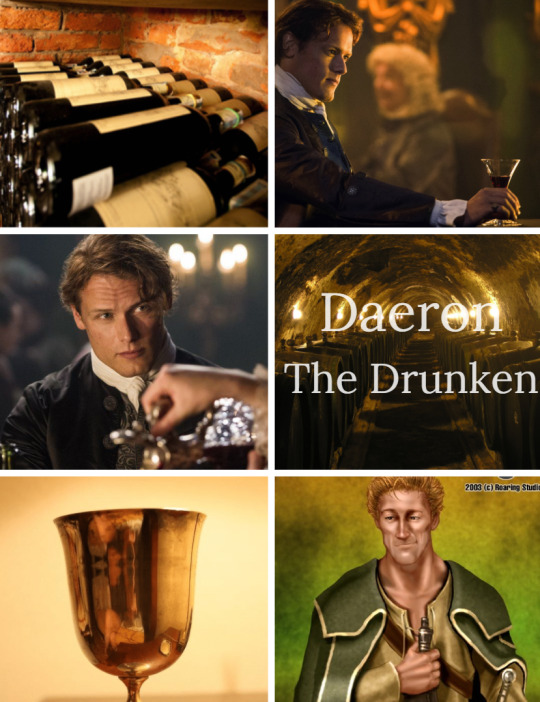
El príncipe Daeron Targaryen, a veces llamado Daeron el Borracho, fue el hijo mayor y heredero del rey Maekar I Targaryen y Lady Dyanna Dayne.
Daeron tenía la piel cetrina, el cabello marrón arena y la barba rubia. No compartía las aficiones de un caballero, detestaba tanto montar como las espadas, prefiriendo en su lugar la bebida y los burdeles. Tenía a menudo sueños proféticos.
Nacido en 190 d.C., el príncipe Daeron fue el hijo mayor del entonces príncipe Maekar Targaryen y Lady Dyanna Dayne. Tuvo cinco hermanos menores, Aerion, Aemon, Aegon, Rhae y Daella. Fue nombrado en honor a su abuelo, el rey Daeron II Targaryen.
Maekar envía a sus hijos Daeron y Aegon al Torneo de Vado Ceniza, con la esperanza de que opacaran al hijo de su hermano Baelor, el príncipe Valarr. Daeron, quien temía a los caballos y a las armas, decidió esconderse de su escolta, llevando a su hermano y escudero Aegon con él. Afeitó la cabeza de Aegon para ocultar sus rasgos Targaryen y se fue a una posada, con el objetivo de emborracharse. Fue en ese lugar que perdió la pista de su hermano menor.
Pensando que algo debía haberles pasado a sus hijos, Maekar sale a buscarlos. Cuando encuentran a Daeron, éste dice que un caballero de enorme estatura se había llevado a Aegon. Posteriormente, se disculpa con Ser Duncan por haber mentido y le dice que no tenía idea que Aegon se había ido. Además, le cuenta un sueño que había tenido. En él, un gran dragón rojo caía sobre Ser Duncan, pero él se levantaba y salía con vida. Daeron le dijo que no sabía el significado del sueño, pero que éstos se hacían realidad frecuentemente, por lo que estaba preocupado por él.
Daeron también dijo a Ser Duncan que no iba a pelear, y que durante la primera justa del Juicio de Siete tenía pensado quedarse en el suelo fingiendo que había sido derrotado, y de paso también retirar sus acusaciones. En el juicio, Daeron fue desmontado por Ser Robyn Rhysling, y cumplió con lo prometido, permaneciendo tendido en el terreno de las justas. Su propio caballo pasó sobre él, pero no quedó herido de gravedad. Resultó al final que el sueño de Daeron era una verdadera profecía, ya que el príncipe Baelor Targaryen murió en brazos de Dunk, tras el golpe mortal que recibió en la cabeza por parte del príncipe Maekar.
Tras el ascenso de su padre al Trono de Hierro y ya como su heredero, el príncipe Daeron prefirió ser conocido como Príncipe de Refugio Estival en lugar de utilizar el tradicional título de Príncipe de Rocadragón, ya que consideraba este lugar como una residencia sombría.
Daeron se casó con Lady Kiera de Tyrosh, y en 222 d.C. tuvo con ella una hija, la princesa Vaella, que resultó ser retrasada. El maestre Aemon sirvió en la fortaleza de su hermano mayor, hasta que Daeron murió de una peste que le había contagiado una prostituta. El asunto de la sucesión al Trono de Hierro se resolvería en el 233 d.C., tras la celebración de un Gran Consejo.
De verdad uno pensaría que el pudo ser rey? Aun que bueno hubiera sido el primer rey borracho antes que Robert Baratheon.
Prince Daeron Targaryen, sometimes called Daeron the Drunk, was the eldest son and heir to King Maekar I Targaryen and Lady Dyanna Dayne.
Daeron had sallow skin, sandy brown hair, and a blond beard. He did not share the hobbies of a gentleman, he detested riding as well as swords, preferring drink and brothels instead. He often had prophetic dreams.
Born in 190 AD, Prince Daeron was the eldest son of then-Prince Maekar Targaryen and Lady Dyanna Dayne. He had five younger brothers, Aerion, Aemon, Aegon, Rhae, and Daella. It was named after his grandfather, King Daeron II Targaryen.
Maekar sends his sons Daeron and Aegon to the Ashford Tournament, hoping they will outshine his brother Baelor's son, Prince Valarr. Daeron, who feared horses and weapons, decided to hide from his escort, taking his brother and squire Aegon with him. He shaved Aegon's head to hide his Targaryen features and went to an inn, aiming to get drunk. It was there that he lost track of his younger brother.
Thinking that something must have happened to his children, Maekar goes out to find them. When they find Daeron, he says that a knight of enormous stature had taken Aegon. Later, he apologizes to Ser Duncan for lying and tells him that he had no idea that Aegon was gone. In addition, he tells her about a dream he had had. In it, a great red dragon fell on Ser Duncan, but he got up and came out alive. Daeron told him that he did not know the meaning of the dream, but that they frequently came true, so he was worried about him.
Daeron also told Ser Duncan that he was not going to fight, and that during the first joust of the Trial of Seven he planned to stay on the ground pretending he had been defeated, and also to withdraw his accusations. At the trial, Daeron was dismounted by Ser Robyn Rhysling, and he delivered on his promise, remaining lying on the fair ground. His own horse passed over him, but was not seriously injured. It turned out in the end that Daeron's dream was a true prophecy, as Prince Baelor Targaryen died in Dunk's arms, following a fatal blow to the head from Prince Maekar.
Following his father's ascension to the Iron Throne and now his heir, Prince Daeron preferred to be known as the Prince of Summer Haven rather than using the traditional title Prince of Dragonstone, as he regarded this place as a gloomy residence.
Daeron married Lady Kiera of Tyrosh, and in AD 222 He had with her a daughter, Princess Vaella, who turned out to be retarded. Maester Aemon served in his elder brother's stronghold, until Daeron died of a plague spread by a prostitute. The matter of the succession to the Iron Throne would be resolved in 233 AD, after the celebration of a Great Council.
Would you really think that he could be king? Although he would have been the first drunken king before Robert Baratheon.
#daeron the drunken#maekar targaryen#dyanna dayne#aerion brightflame#maester aemon#kiera of tyrosh#vaella targaryen#vaella the simple
20 notes
·
View notes
Note
How different do you think the Targaryen succession following Maekar's death would have turned out if Daeron the Drunken had had a son instead of a daughter (Vaegon instead of Vaella, perhaps)? Especially if his child remained 'simple', as described in canon (for whatever simple means)? Would there still have been a Council called to debate the question? Would they have dismissed the claim, or been able to do it that easily? And if not, how do you think it might have worked out?
To be honest, I don’t really think that changes much if Vaegon is still considered to be simple and incapable of ruling in his own right. He’d be about 11 at the time, so it seems like it’d be fairly apparent to the court if he had some sort of intellectual disability. There’d still be a Great Council and they’d still settle on Aegon V, and likely send Vaegon to the Faith to get him out of the way in case someone tried to take him under their wing to raise a claim against Aegon.
And if Vaegon was not seen as ‘simple’, he’d probably be acclaimed heir, with no reason to call a Great Council. They’d nominate a regent instead, maybe Kiera and Aemon or Aegon, or both Aemon and Aegon as a coalition against Bloodraven, viewing him likely to try to sweep in and control the next 5 years of regency through whatever means necessary.
15 notes
·
View notes
Text
Dowry vs. Bride Price: Westeros and Tyrosh
Westeros has a dowry system, where a woman is given wealth (commonly in the form of portable property) by her father’s family upon her marriage; in medieval Europe the property is usually hers or her children’s to use, but in Westeros her husband has significant rights over it and can be the chief reason for their marriage. The most notable example is Walda Frey’s marriage to Roose Bolton, where the dowry was her weight in silver paid by her grandfather Walder to Roose. Furthermore, Lord Lyonel Corbray is even more "well pleased” with his second wife’s “immense” dowry than with the girl herself, as she is the daughter of a wealthy Gulltown merchant. Westeros is based on medieval Europe and is clearly patrilineal (lineage is traced from father to son) and patrilocal (the family resides near the husband’s parents); dowries were offered in such societies where land is valued more than manual labor, due to the concentration of land ownership in the hands of the few (the aristocracy).
We don’t have many detailed instances of Tyroshi marriage, but the cases we do know about seem to indicate that Tyrosh has a system of bride price, where a man or his family give a woman (or, more specifically, her parents) property or service either just before or even during their marriage. Aegon IV explicitly promised some form of wealth to the Archon for Daemon to marry Rohanne of Tyrosh, which Daeron II had to pay for the marriage to take place; Yandel referred to the exchange as a dowry, but he is clearly looking at this situation from a Westerosi lens, as dowries outside of the Daemon/Rohanne marriage are only mentioned as being settled on women. Rohanne’s bride price may seem like a special case akin to Daenerys’ wedding to Hizdahr zo Loraq, where the bride is of a much higher status than the groom and so their union necessitates a reversal of custom, but Fire and Blood introduces another Tyroshi wedding that seems to follow the practice of bride service: that of Orryn Baratheon and the Archon’s daughter. We are most familiar with bride service from the biblical Genesis, in which Jacob serves Laban for seven years in order to marry Laban’s daughter Rachel (although Laban tricked him into marrying his eldest daughter Leah, so Jacob had to labor seven more years for Rachel’s hand). Orryn, exiled from Westeros for 10 years, took service with the Archon and within one year had married his daughter, although after the marriage he continued to serve the Archon until his term was over (in real-world societies including in ancient Jewish law, sometimes the service/price is not paid all at once and the groom enters a contract where he promises to pay what he owes). Orryn’s exile status meant that he had no family to pay bride price, so he needed to take bride service under the Archon to wed his daughter. Bride price/service occurs in societies where manual labor is more valuable than land, and we can infer Tyrosh, a heavily urban, small, “bleak and stony island” does not value land as the main source of economic wealth; rather, manual labor seems to be essential, whether through the institution of slavery (slaves are said to outnumber freeborn Tyroshi three to one) or from mercenary companies. According to an evolutionary psychology theory, bride price also originates from polygamy since there is a relative scarcity of unmarried women, and we know from Racallio Ryndoon’s dozen wives that some polygamy is practiced in Tyrosh.
Some inferences about how Tyrosh’s bride price custom and how that may have impacted Tyroshi-Westerosi relationships under the cut:
Tyrosh is majority uxorilocal/matrilocal, perhaps even somewhat matrilineal: bride service in particular necessitates the couple living close to the bride’s parents. The children of Rohanne and the Archon’s daughter were both raised in their mother’s lands; obviously from necessity in Rohanne’s case, but the Archon’s daughter never went to Westeros with her own daughter to try to raise her near Storm’s End after her father’s term was over. It seems fairly easy to assume that Tyroshi “citizenship” is based on the origins of the mother, as it was in ancient Rome (all children of freeborn women were free no matter their fathers’ status), GRRM’s model for Valyria. Matrilineality facilitates the incorporation of foreigners into the society, which is important for mercantile Tyrosh.
This is partially the reason for the imbalance between the number of Tyroshi men versus women in the books when this is not the case for their ‘sister cities.’ Several Tyroshi men appear in the books as sea captains and sellswords, and background Tyroshi sailors are easily distinguished by their dyed hair. Lyseni women have been significant side characters since book one (with Doreah, who is Dany’s slave) and are in-universe famous for being the beautiful consorts of Westerosi kings. There are even some Myrish women who have recent prominence in Taena and Serala (note: it isn’t said whether or not they are related to any Myrish magisters). The only Tyroshi women who have prominence are long dead nobility, Rohanne and Kiera and the Archon’s daughter (all three are certainly connected to the Archon in some fashion). In a matrilocal society, the women do not often leave their natal home (whereas in a patrilocal society women have to reside with their husband’s family), while the men frequently leave in order to make their fortune and thus be able to afford the bride price. If the city is matrilineal, the glut of male Tyroshi expats makes even more sense since they will not be able to inherit most of their mother or father’s property, so leaving the island is often the only way to make a decent living.
The bride price practice explains why Kiera of Tyrosh, unique among Westerosi royal consorts, was married to two Targaryen princes: Valarr died in 209 in the Great Spring Sickness, while Kiera’s only living child Vaella was born in 222. We don’t know when Kiera and Daeron were married, but the age gap between her stillborn sons (pre-208) and daughter is big enough (at least 14 years) that whoever Archon Kiera was related to might have had his term expire, and issues of her fertility might’ve caused other related Tyroshi women to be recommended for the crown prince. But the double marriage to Kiera may have happened because amid a country wracked by a devastating plague, ironborn raids, a hard-fought rebellion, and rampant tyranny, the crown simply did not have the funds to pay another bride price.
The Blackfyre daughters were able to marry well, whereas it was difficult to find matches for the sons: Daemon had seven sons, five of whom reached adulthood, but we know only of two or perhaps three (Haegon and Captain Daemon’s father; if you don’t believe Maelys was Haegon’s son, then his father as well) who had sons that carried on the Blackfyre name. In an aristocratic society with a dowry system like Westeros, the Blackfyre brothers could have traded on their noble birth and royal blood to marry an heiress (even a wealthy merchant’s daughter like Lyonel Corbray did), but in Tyrosh they would’ve needed to pay a bride price or spend years in bride service. This could explain why Daemon II was clearly not married by age 22 (yes he was gay, but so was Laenor Velaryon and he wed Rhaenyra at age 20), partially why Haegon waited so long to cross the Narrow Sea (he was in bride service beforehand, and after he needed a few sons to secure the succession), and perhaps even why Aenys Blackfyre traveled to the Great Council to become king while his nephew was crowned (he didn’t have a male heir). A bride price system might explain why the male Blackfyre line died out by three generations when there had been so many heirs, if the family wealth was mostly tied up in marriage dues.
As for the daughters, I’m fairly certain that after the family went into exile, the proposed betrothal between Aegor and Calla was scrapped due to lack of advantages (Aegor was now a landless sellsword whereas Calla was one of perhaps three exiled princesses and relative of the Archon). Calla or her sisters would’ve been a brilliant match for any ambitious, wealthy Essosi magister who wanted leverage over the Targaryens. Bloodraven’s statement in The Mystery Knight that Daemon II’s brothers and sisters would seek revenge if he executed Daemon II indicates that the sisters were powerful and capable of claiming the throne (if their brothers had died), which probably made them more attractive matches. The wealth their marriages brought the family might’ve helped the female line survive to canon era, though in a much better position than is usually speculated.
#asoiaf#asoiaf meta#tyrosh#marriage#asoiaf theories#Rohanne of Tyrosh#House Blackfyre#archon's daughter#orryn baratheon#kiera of tyrosh#calla blackfyre
49 notes
·
View notes
Note
Hello, just saw your gallery through. A nice one at that btw I love your take on Targaryens. You consider suggestions so I would like to put forward mine: Daeron Targaryen (son of Maekar I) The Drunken and Kiera of Tyrosh with their only daughter, sweet Vaella. You see, I'm into barely known Targaryen families but artwork about them is nonexistent sadly. Would be much appreciated!
OHHH just the idea of drawing someone from Tyrosh is exciting! I’m looking in the asoiaf wiki but I haven’t read the Dunk and Egg books yet, I guess that would help me visualize the character better. But I like this idea!
4 notes
·
View notes
Photo
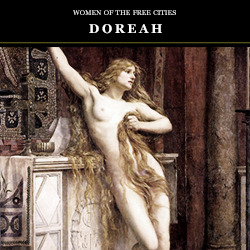
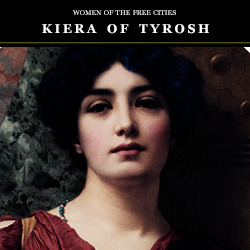
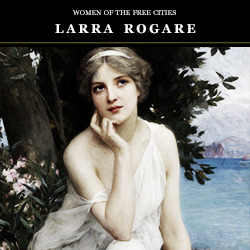
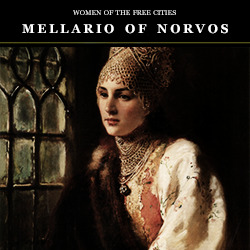

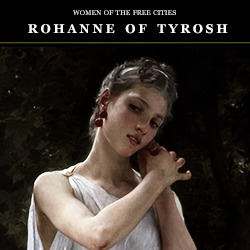


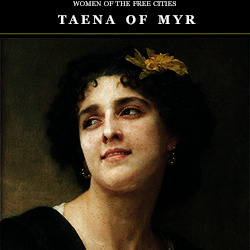

Women of the Free Cities
Doreah
Doreah a fair-haired, blue-eyed Lysene girl. “These are no common servants, sweet sister,” her brother told her as they were brought forward one by one. “Illyrio and I selected them personally for you. Doreah will instruct you in the womanly arts of love.”
Kiera of Tyrosh
Wife of Valarr and Daeron the Drunken Targaryen and mother of Vaella Targaryen.
Larra Rogare
After his years as a hostage in Lys following the Dance, Viserys returned to King’s Landing with a beautiful Lyseni bride, Larra Rogare, the daughter of a wealthy and influential noble house. Tall and willowy, with the silver-gold hair and purple eyes of Valyria (for the blood still runs strong in Lys), she was seven years Viserys’s elder. She was also a woman who never felt a part of the court and was never truly happy there. Yet she gave him three children before she at last returned to her native Lys.
Mellario of Norvos
“I saw Volantis once, on my way to Norvos, where I first met Mellario. The bells were ringing, and the bears danced down the steps. Areo will recall the day.”
Old Mother
THE OLD MOTHER: A pirate queen.
Rohanne of Tyrosh
He paid the dowry that Aegon had promised to the Archon of Tyrosh, thereby seeing his half brother Daemon Blackfyre wed to Rohanne of Tyrosh as Aegon had desired, for all that Ser Daemon was only four-and-ten.
Serala of Myr
“In Duskendale they love Lord Denys still, despite the woe he brought them. ’Tis Lady Serala that they blame, his Myrish wife. The Lace Serpent, she is called. If Lord Darklyn had only wed a Staunton or a Stokeworth … well, you know how smallfolk will go on. The Lace Serpent filled her husband’s ear with Myrish poison, they say, until Lord Denys rose against his king and took him captive.”
Serra of Lys
“A maiden? I know the way of that.” Illyrio thrust his right hand up his left sleeve and drew out a silver locket. Inside was a painted likeness of a woman with big blue eyes and pale golden hair streaked by silver. “Serra. I found her in a Lysene pillow house and brought her home to warm my bed, but in the end I wed her.”
Taena of Myr
“Merry” was what she was to call boisterous plump Meredyth Crane, but most definitely not Lady Merryweather, a sultry black-eyed Myrish beauty.
Trianna of Volantis
“Some of the first elephants were women,” she said, “the ones who brought the tigers down and ended the old wars. Trianna was returned four times. That was three hundred years ago, alas. Volantis has had no female triarch since, though some women have the vote.”
#free cities#asoiafedit#the world of ice and fire#a song of ice and fire#art#art history#artasoiaf series#nanshe's graphics
231 notes
·
View notes
Photo

Daenerys' Not direct Male Ancestors (7)
Rhaegel Targaryen (??? - 215 d. C.)
Son of Daeron II and Myriah.
He possessed Targaryen Madness.
He was heir to his brother, but he drowned with a lamprey cake.
Daeron Targaryen (190 d. C. - ???)
Nicknamed the drunk.
Maekar and Dyanna Dayne's eldest son.
Married to Kiera of Tyrosh and a retarded daughter, Vaella.
Aerion Targaryen (192 d. C. - 232 d. C.) (40 años/ years)
He was the holder of Targaryen Madness, coming to think that he was a dragon.
He died drinking a cup of Valyrian fire.
8 notes
·
View notes